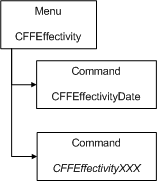Effectivity Menu | ||
| ||
This diagram shows the Effectivity menu structure:

The date command comes with Configuration and Effectivity Services; application developers can add additional commands as needed, but should use the shown naming convention.
If defining a custom command for the Type menu, use the settings defined in this table:
| Setting Name | Description | Accepted Values/Examples |
|---|---|---|
| Label | The string resource value used to display the name of the command in the Type menu. Make sure to also add the string resource to the string resources file for the application. | Effectivity.EffectivityType.Unit |
| Format | The type of data this command will display. |
|
| Mode | Optional. Defines the menu to use for the Mode field. If defined, the Mode menu also displays in the dialog box. If not defined, the Mode field does not display in the dialog box. | CFFUnitModeMenu |
| Registered Suite | The application the UI component belongs to. The system looks for files, such as string resources and properties, in the registered directory for that application, which is specified in emxSystem.properties. | Effectivity |
| allowRange | If true, the Insert as Range check box displays; if false, the check box does not display. |
|
| categorytype | Determines how to format and display this effectivity type in the Effectivity Definition dialog box. |
|
| clearSelection | Specifies if the structure browser selections should be cleared after an expression has been inserted. |
|
| includeContextProgram | Optional. Specifies a custom program and method to call to populate the table in the Effectivity Selector field. If specified, this setting overrides the showContext.jsp parameter. | JPO program:method emxPUEBase:getContextProducts |
| keyword | 2 letter keyword used to parse the Effectivity Expression attribute, where:
|
|
| relationship | When format=structure is defined, either the relationship or expandProgram setting must also be defined. If both settings are defined, expandProgram is used. Used to expand the context objects in the Effectivity Selector table. |
|
| expandProgram | When format=structure is defined, either the relationship or expandProgram setting must also be defined. If both settings are defined, expandProgram is used. Used to expand the context objects in the Effectivity Selector table. | JPO name |
| searchType | Defines the search page to use when clicking the search icon. |
|
| sequenceSelectable | If categoryType=sequence,,defines the selectable used to access the sequence value. For example, when Unit effectivity is used, the sequence defined by the Build Unit Number should be specified. When Product effectivity is used, evaluate[revindex + 1] should be defined for this setting. Used to display in effectivity expressions. |
|
| showAnd | Shows or hides the AND button for use in building the effectivity expression. If there is a single effectivity type, AND does not make sense, and if used, creates an invalid expression. Hiding the button in this use case prevents this problem. True shows the button. If this parameter is set for the dialog box JSP (see URL Parameters To Pass to the Dialog) and the command, then the command's value overides the JSP value. |
|
| showOr | Shows or hides the OR button for use in building the effectivity expression. True shows the button. If this parameter is set for the dialog box JSP (see URL Parameters To Pass to the Dialog) and the command, then the command's value overides the JSP value. |
|
| selection | Specifies if the table shown in the Effectivity Selector field includes radio buttons (for single selections) or check boxes (for multiple selections). |
|
| table | The table to show in the Effectivity Selector. | CFFDefinitionTable (default) |